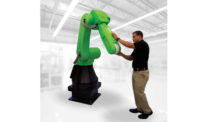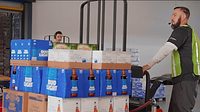With a growing number of products in the marketplace and an evolving retail landscape, beverage warehouses are faced with a lot of work and a minimal amount of time and manpower to do it. As robotic technology becomes more accessible, it’s helping many manufacturers achieve their operations goals.
“Robotics in the beverage industry made initial inroads in the palletizing space and continue to be a viable technology for many of these types of applications,” says Matt Wicks, vice president of product development and manufacturing systems at Intelligrated, Mason, Ohio. “We’re seeing that robotic technology has migrated to and merged with more ‘conventional’ palletizing machines to yield improved performance in case handling and machine rates.”
He notes that robotic automation also can help companies dealing with the impacts of eCommerce and labor challenges. “Labor continues to be a challenge for manufacturers. Maintaining a consistent and reliable workforce is challenging as the demands of eCommerce and order fulfillment systems drain the resource pool. Leveraging automation and robotics can help to offset these challenges,” he says.
Ed Mullen, vice president of sales in North America at Demark-based Mobile Industrial Robots (MiR) also notes the proliferation of robotics in the beverage industry, and notes changing regulations as among the factors influencing implementation.
"As in other industries, the beverage industry is increasingly using automation and robots due, in part, to increasing food safety regulations combined with an increasing focus on maintaining competitive advantage," he says. "Regardless of the type of beverage, products need to reach the market fast, and companies in the beverage industry need flexible, fast and adaptable production to produce effectively and meet market requirements. At the same time, the robots minimize the risk for human contamination of the products, helping meet the industry's strict hygienic requirements."
Timothy J. Schiller, national accounts manager at KUKA, Shelby Township, Mich., notes that speed and flexibility drive operations decisions in the beverage industry and have influenced the growing integration of robotics in the industry.
“Both can/bottle suppliers, as well as beverage manufacturers, need to be able to provide massive quantities of product to their respective customers, but they also need systems that are able to handle the rapidly changing packaging materials preferred by consumers,” he says.
When it comes to end-of-line operations, the beverage industry has increasingly embraced the efficiency of robotics, as they have become easier to use and more convenient, says Wesley Garrett, authorized system integrator account manager for pick/pack/pal at FANUC America Corp., Rochester Hills, Mich.
“Robots are incorporated into beverage packing machines due to the flexibility and ease of engineering as opposed to conventional gantry-style machines,” he says. “Robotic integrators are finding that if motion is required, it is easier, faster and, typically, more cost-effective to use a robot.”
He adds that high-speed, repetitive and challenging ergonomic tasks are handled with ease by robots.
Yet, Schiller notes that robotic solutions also are being used in a variety of operations at the beginning of the beverage manufacturing process.
“Robots were originally used in the beverage industry mainly just to palletize cases of beverages, but now, robots can be seen throughout the manufacturing process,” he explains. “KUKA robots are being used at the beginning of the manufacturing process to depalletize cases and bags of raw product. KUKA robots are used to cut off straps and remove stretch-wrap from incoming pallets of empty bottles and cans, and also to depalletize layers of these items from the pallet so they can [be] entered into filling machines.”
Advancing technology
In line with growing implementation, robotics technology continues to improve on the hardware and software sides, experts note. Today, robots are easier to integrate than ever before, FANUC’s Garrett says.
“Today’s robots are faster, lighter and have greater duty capabilities,” he explains. “Other noteworthy improvements are the software and controller platforms driving the robotic arms.”
On the software side, innovations have allowed for easier-to-use systems with high performance, Intelligrated’s Wicks says.
“Machine learning, more data collection and analytics are encroaching into the industry,” he says. “Machine vision, advanced algorithms and sensing solutions continue to be integrated into sophisticated robotic solutions to solve automation problems.”
He adds that advancements in machine vision and software will enable quick product turnover and easily adaptable palletizing equipment.
KUKA’s Schiller notes that Human-Robot Collaboration (HRC), which allows humans and robots to work alongside one another in the same area, is yet another advancement making changes in the way beverage facilities are utilizing robotics.
MiR's Mullen expands on this and adds that transport robots also are proliferating. "One of the main advancements that have changed the way we use robots is the rise of the collaborative robots (cobots), which are designed to share work space with humans," he explains. "With cobots, the initial cost of integrtion and production floor disruption is reduced since they do not require safety measures. These multi-purposed robots are usually simple to program and integrate, and can perform a number of tasks.
"We're also seeing great advancements in transport robotics. Autonomous mobile robots (AMRs) are collaborative and have changed material handling in this industry and many others," he continues. "Until recently, in-house transportation tasks have been solved manually by humans or by automated guided vehicles (AGVs) that are only able to follow fixed routes and require expensive and rigid installation such as wires or magnetic strips to navigate. The AMRs have sophisticated software that can navigate intelligently via 3D cameras, senors and laser scanners; thus, they do not need any guidance. If they meet any obstacles on their way, they just navigate around them and find the fastest route to the target. Like other cobots, they are easy to program and cost effective because of the fast and easy installation; super flexible, and can be used for all kinds of in-house transportation tasks."
Picking robots
Although robotics offer a variety of solutions, experts note that several factors should be considered when deciding what and how to integrate this type of automation. First among them is finding the right supplier partner.
“Beverage companies should consider [the] level of expertise and certifications of the company they are contracting for their robotic integration,” Intelligrated’s Wicks advises. “With robotic palletizing, it’s fairly easy for an organization to call themselves a robotic integrator and get into the business of offering robotic palletizing solutions.
“Companies just getting into automation/robotics sometimes may not realize the safety and training considerations, their responsibility to comply with industry regulations and the total cost of ownership associated with a typical robot installation,” he continues. “By selecting a certified robotic integrator, they can have the assurance that the integrator has met the processes, experience and skills required by the [Robotics Industry Association] (RIA) certified integrator program.”
Another consideration should be the areas of operations in which robotics would be a benefit, FANUC’s Garrett notes.
“There are a number of drivers when looking to start robotic automation,” he says. “The best places are areas of low-hanging fruit or simple operations to automate. Then look at production bottle necks; these areas can have very positive impacts on [return on investment] (ROI) not only for labor force relief but for increasing production capacity and eliminating overtime. Then consider areas with heavy lifting and poor ergonomics that cause work loss.”
MiR's Mullen notes that companies should consider three factors: the amount of space in a facility, how the robot might change workflows, and the internal technical resources required when integrating robots.
"We advise companies to start small," he says. "Even though they have tasks for a whole fleet of mobile robots, we advise them to start with just a couple of robots and get to know them. Then, the integration of more robots across more applications will be very fast and easy."
Employee acceptance also is a consideration many companies should discuss before integrating robotics into their operations, KUKA’s Schiller says.
“Many employees fear robotic-based automation because they are worried about losing their jobs, but numerous studies have shown that robot-based automation actually increases employment, and generally, with higher-paying jobs,” he explains.
Additionally, ROI is universally considered. Experts say that ROI is variable depending on several factors. “Robotic systems can vary greatly depending on the content, size of robot and intelligence needed in a system,” FANUC’s Garrett says. “Small robotic systems can have ROIs of less than a year. Larger systems can typically achieve a two-year ROI depending on the number of shifts that [the] manufacturer may have.” BI





